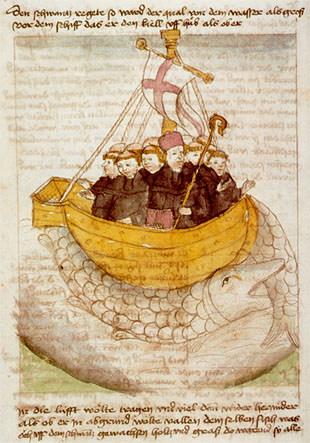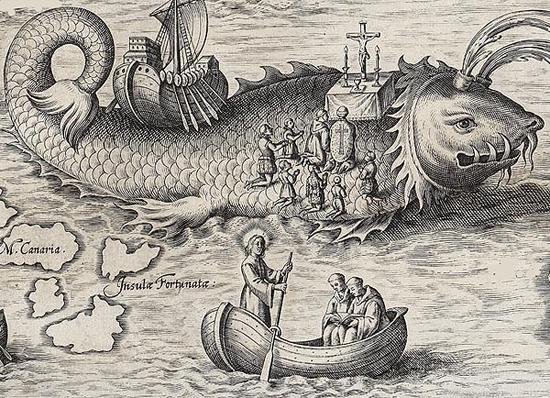Saint Brendan of Clonfert – An Irish Saint (May 16)
16 Μαΐου 2010
![]() Saint Brendan’s feast day is celebrated on May 16 by Eastern Orthodox Christians, Anglicans and Roman Catholics .
Saint Brendan’s feast day is celebrated on May 16 by Eastern Orthodox Christians, Anglicans and Roman Catholics .
Brendan of Clonfert or Bréanainn of Clonfert (c. 484 – c. 577) (Irish: Naomh Breandán ) called “the Navigator”, “the Voyager”, or “the Bold” is one of the early Irish monastic saints. He is chiefly renowned for his legendary quest to the “Isle of the Blessed,” also called St. Brendan’s Island. The Voyage of St. Brendan could be called an immram (Irish navigational story). He was one of the Twelve Apostles of Ireland.
In 484 Saint Brendan was born in Ciarraighe Luachra near the port of Tralee, in County Kerry, in the province of Munster, in the south west of Ireland. He was baptized at Tubrid, near Ardfert, by Saint Erc. For five years he was educated under Saint Ita, “the Brigid of Munster”, and he completed his studies under Saint Erc, who ordained him priest in 512. Between the years 512 and 530 St Brendan built monastic cells at Ardfert, and, at the foot of Mount Brandon, Shanakeel— Seana Cill, usually translated as “the old church”— also called Baalynevinoorach.
From here he is supposed to have set out on his famous seven years voyage for Paradise. The old Irish Calendars assigned a special feast for the “Egressio familiae S. Brendani”, on March 22; and St Aengus the Culdee, in his Litany composed at the close of the eighth century, invokes “the sixty who accompanied St. Brendan in his quest for the Land of Promise”.
Hagiographers “know of Brendan chiefly from four sources- the Irish Lives, the Latin Lives, the Latin Navigatio Sancti Brendani Abbatis and many vernacular versions of his voyage in the emerging languages of Europe, collectively known as the Voyage of Brendan. We also know of Brendan from the frequent mentions of him in the lives of other saints and in many calendars and martyrologies that have survived in Ireland and in Scotland.
There is, however, very little secure information concerning his life, although at least the approximate dates of his birth and death, and accounts of some events in his life, are found in the Irish annals and genealogies. The principal works devoted to the saint and his legend are a ‘Life of Brendan’ in several Latin and Irish versions (Vita Brendani / Betha Brenainn) and the better known ‘Voyage of Saint Brendan the abbot’ (Navigatio sancti Brendani abbatis). Unfortunately, the Lives and the Voyage provide little reliable information about his life and travels; they do, however, attest to the development of his cult in the centuries after his death. An additional problem is that the precise relationship between the Vita and the Navigatio traditions is uncertain.
Just when the Vita tradition began is uncertain. The surviving copies are not earlier than the end of the twelfth century, but scholars suggest that a version of the Life was composed before the year 1000. The Navigatio was probably written earlier than the Vita, perhaps in the second half of the eighth century.
Any attempt to reconstruct the details of the life of the real Brendan or to understand the nature of the Brendan legend has to be based principally on the Irish annals and genealogies and on the various versions of the Vita Brendani.
Legendary journey
St Brendan is chiefly renowned for his legendary journey to The Isle of the Blessed as described in the ninth century Voyage of St Brendan the Navigator. Many versions exist, that tell of how he set out onto the Atlantic Ocean with sixty pilgrims (other versions have fourteen, plus three unbelievers who join at the last minute) searching for the Garden of Eden. One of these companions is said to have been Saint Malo, the namesake of Saint-Malo. If it happened, this would have occurred sometime between 512-530 AD, before his travel to the island of Great Britain. On his trip, Brendan is supposed to have seen St. Brendan’s Island, a blessed island covered with vegetation. He also encountered a sea monster, an adventure he shared with his contemporary St. Columba. The most commonly illustrated adventure is his landing on an island which turns out to be a giant sea monster called Jasconius or Jascon. This too, has its parallels in other stories, not only in Irish mythology but in other traditions, from Sinbad the Sailor to Pinocchio.
Early Dutch version
 One of the earliest preserved written versions of the legend is in Dutch De Reis van Sint Brandaen (Mediaeval Dutch for On the Voyage of Saint Brendan), written in the 12th century. Scholars believe it derived from a now lost middle High German text combined with Celtic elements from Ireland and combines Christian and fairy tale elements. Des Reis van Sint Brandaen describes “Brandaen,” a monk from Galway, and his voyage around the world for nine years. The journey was begun as a punishment by an angel who had seen Brendan not to believe the truth of a book on the miracles of creation and saw Brandaen throw it into the fire. The angel tells him that truth has been destroyed. On his journeys Brandaen encounters the wonders and horrors of the world, such as Judas frozen on one side and burning on the other, people with swine heads, dog legs and wolf teeth carrying bows and arrows, and an enormous fish that encircles the ship by holding its tail in its mouth. The English poem Life of Saint Brandan is a later English derivative of the Dutch version.
One of the earliest preserved written versions of the legend is in Dutch De Reis van Sint Brandaen (Mediaeval Dutch for On the Voyage of Saint Brendan), written in the 12th century. Scholars believe it derived from a now lost middle High German text combined with Celtic elements from Ireland and combines Christian and fairy tale elements. Des Reis van Sint Brandaen describes “Brandaen,” a monk from Galway, and his voyage around the world for nine years. The journey was begun as a punishment by an angel who had seen Brendan not to believe the truth of a book on the miracles of creation and saw Brandaen throw it into the fire. The angel tells him that truth has been destroyed. On his journeys Brandaen encounters the wonders and horrors of the world, such as Judas frozen on one side and burning on the other, people with swine heads, dog legs and wolf teeth carrying bows and arrows, and an enormous fish that encircles the ship by holding its tail in its mouth. The English poem Life of Saint Brandan is a later English derivative of the Dutch version.
Effects
As the legend of the seven years voyage spread, crowds of pilgrims and students flocked to Ardfert. Religious houses were formed at Gallerus, Kilmalchedor, Brandon Hill, and the Blasket Islands, in order to meet the wants of those who came for spiritual guidance from Saint Brendan. Saint Brendan is the Patron Saint of sailors and travelers. At the United States Naval Academy in Annapolis, Maryland, a large stained glass window commemorates Brendan’s achievements. At Fenit Harbour, Tralee, a substantial bronze sculpture with a small horn has been erected to the memory of Brendan.
Context
As a genre, The Voyage of St. Brendan (in Latin, the Navigatio Sancti Brendani) fits in with a then-popular form of literature, peculiar to Ireland, called an immram, that describes a hero’s series of adventures in a boat. For example, there appear to be similarities with The Voyage of Bran written much earlier. In the Navigatio, this style of storytelling meshed with a religious ascetic tradition where Irish monks would travel alone in boats, the same way their desert brothers used to isolate themselves in caves.
Brendan is one of the most famous Irish saints. His voyages created one of the most remarkable and enduring of European legends. With much of Brendan’s journeys coming from the Navigatio it has been difficult for scholars to interpret what it factual and what is folklore. Irish immram flourished during the seventh and eighth centuries. Typically, an immram was a sea-voyage in which a hero, with a few companions, often monks, wanders from island to island, meets other-world wonders, and finally returns home. The story of Brendan’s voyage, developed during this time, shares some characteristics with immram. Like an immram, the Navigatio tells the story of Brendan, who, with some companion monks, sets out to find the terra repromissionis sanctorum, the Promised Land of the Saints or the Earthly Paradise.[7]
Possible link to Columbus
While the story is often assumed to be a religious allegory, there has been considerable discussion as to whether the legends are based on actual events, including speculation that the Isle of the Blessed was actually America. There is a St. Brendan Society that celebrates the belief that Brendan was the first European to reach America. Tim Severin demonstrated it is possible that a leather-clad boat such as the one described in the Navigatio could have reached North America.[8][9] Some have alleged that Christopher Columbus relied on the manuscript “Navigatio sancti Brendani abbatis” that told of St. Brendan’s travels across the Atlantic. It is well established that Columbus went to look for St. Brendan’s Isle when he discovered the West Indies.[citation needed] As a student of the University of Pavia, Columbus would have learned of Brendan’s voyage from the manuscripts brought there, seven hundred years previously, by Dugal, student and founder of the University of Pavia. On the eve of his great voyage in 1492 he wrote: “I am convinced that the terrestrial paradise is in the Island of Saint Brendan, which none can reach save by the Will of God.
Later life
Brendan travelled to Wales and the holy island of Iona, off the west coast of Scotland; returning to Ireland, he founded a monastery at Annaghdown, where he spent the rest of his days. He also founded a convent at Annaghdown for his sister Briga. He was recognized as a saint by the Irish Church, and his feast day was celebrated on May 16. Having established the bishopric of Ardfert, St. Brendan proceeded to Thomond, and founded a monastery at Inis-da-druim (now Coney Island), in the present parish of Killadysert, County Clare, about the year 550. He then journeyed to Wales, and thence to Iona, for he is said to have left traces of his apostolic zeal at Kil-brandon (near Oban) and Kil-brennan Sound. After a three years’ mission in Britain he returned to Ireland, and did more proselytizing in various parts of Leinster, especially at Dysart (County Kilkenny), Killiney (Tubberboe), and Brandon Hill. He established churches at Inchiquin, County Galway and at Inishglora, County Mayo. He died c. 577 at Annaghdown, while visiting his sister Briga. Fearing that after his death his devotees might try to make off with his remains, Brendan had arranged before dying to have his body carried back to Clonfert secretly, concealed in a luggage cart bound for the monastery. He was buried in Clonfert cathedral.
Source: Wikipedia




